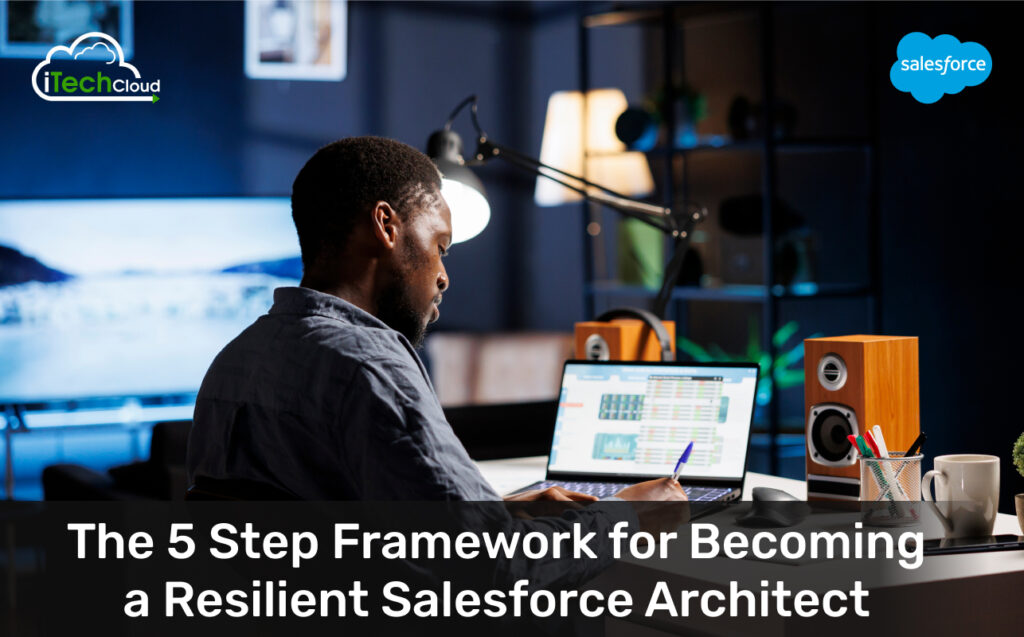The 5 Step Framework for Becoming a Resilient Salesforce Architect

Introduction
In the ever-evolving world of Salesforce, architects play a crucial role in designing scalable, secure, and high-performing solutions. However, with rapid technological advancements, increasing business demands, and complex integration requirements, resilience is key to long-term success.
A resilient Salesforce architect is not just technically proficient but also adaptable, strategic, and capable of navigating challenges while maintaining system integrity. This blog outlines a 5-step framework to help aspiring and experienced Salesforce architects build resilience in their careers.
Table of Contents
Step 1: Master the Core Architectural Principles
Before diving into advanced concepts, a resilient architect must have a strong foundation in Salesforce’s core architectural principles.
Key Areas to Focus On:
1. Data Modeling & Management
- Understand normalization vs. denormalization.
- Master relationships (lookup, master-detail, junction objects).
- Learn Big Objects and External Objects for large datasets.
2. Security & Compliance
- Implement robust sharing & visibility models (OWD, roles, profiles, permission sets).
- Ensure compliance with GDPR, HIPAA, and SOX.
- Use platform encryption and MFA for enhanced security.
3. Integration Patterns
- Know when to use REST vs. SOAP APIs.
- Understand Event-Driven Architecture (Platform Events, CDC, CometD).
- Leverage middleware (MuleSoft, Informatica) for complex integrations.
4. Performance Optimization
- Apply query optimization (SELECTIVE queries, indexing).
- Use async processing (Batch Apex, Queueable, Future Methods).
- Implement caching strategies (Lightning Data Service, Session Cache).
Why This Matters:
A resilient architect anticipates problems before they arise by adhering to best practices. Without a solid foundation, even the best-designed solutions can fail at scale.
Step 2: Develop a Solution-First Mindset
Salesforce architects must think beyond technology they must align solutions with business goals.
How to Cultivate This Mindset:
1. Understand Business Processes
- Engage with stakeholders to map real business needs.
- Avoid over-engineering solve problems efficiently.
2. Design for Scalability & Flexibility
- Use custom metadata instead of hardcoding.
- Implement modular architecture for easy updates.
3. Balance Technical Debt & Innovation
- Not every problem requires the latest feature.
- Prioritize maintainability over cutting-edge tech when necessary.
Why This Matters:
A resilient architect ensures that Salesforce solutions grow with the business, avoiding costly rework.
Step 3: Strengthen Soft Skills & Leadership
Technical skills alone don’t make a great architect communication, leadership, and adaptability are critical.
Essential Soft Skills for Architects:
1. Stakeholder Management
- Translate technical jargon into business value.
- Manage expectations and negotiate trade-offs.
2. Conflict Resolution
- Mediate between developers, admins, and business teams.
- Advocate for best practices without alienating teams.
3. Mentorship & Collaboration
- Guide junior team members.
- Foster a culture of continuous learning.
Why This Matters:
A resilient architect bridges the gap between IT and business, ensuring smooth project execution.
Step 4: Embrace Continuous Learning & Certification
Salesforce releases three major updates per year staying updated is non-negotiable.
Strategies for Continuous Growth:
1. Pursue Advanced Certifications
- CTA (Certified Technical Architect) – The pinnacle for architects.
- Application & System Architect Paths – Build expertise step-by-step.
2. Engage with the Salesforce Community
- Attend Dreamforce, TrailheadDX, and local meetups.
- Participate in Salesforce Stack Exchange, Ohana Slack.
3. Experiment with New Features
- Use Developer Orgs & Sandboxes to test new releases.
- Explore AI (Einstein), DevOps (Copado), and Composable CRM.
Why This Matters:
A resilient architect stays ahead of industry trends, ensuring they can leverage new capabilities effectively.
Step 5: Build a Risk Mitigation & Recovery Plan
Even the best architectures face failures resilience means preparing for the worst.
Key Risk Mitigation Strategies:
1. Disaster Recovery Planning
- Implement backup strategies (Own Backup, Salesforce Data Export).
- Define RTO (Recovery Time Objective) & RPO (Recovery Point Objective).
2. Governance & Change Management
- Use CI/CD pipelines (Salesforce DX, GitHub Actions).
- Enforce code reviews & automated testing.
3. Performance Monitoring & Optimization
- Use Salesforce Health Check and Event Monitoring.
- Set up proactive alerts for system degradation.
Why This Matters:
A resilient architect minimizes downtime and ensures business continuity, even during crises.
Conclusion: The 5 Step Framework for Becoming a Resilient Salesforce Architect
The 5 Step Framework for Becoming a Resilient Salesforce Architect emphasizes the importance of mastering core Salesforce principles, adopting a strategic mindset, staying adaptable through continuous learning, strengthening communication skills, and fostering collaboration across teams. These steps not only build technical proficiency but also equip architects to handle complex challenges with confidence and agility. By consistently applying this framework, professionals can future-proof their careers, lead successful digital transformations, and become trusted advisors in the Salesforce ecosystem.

